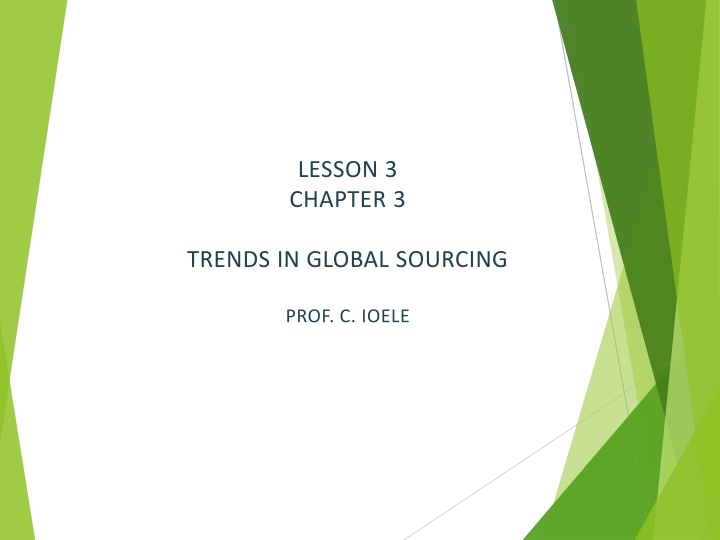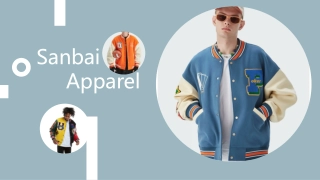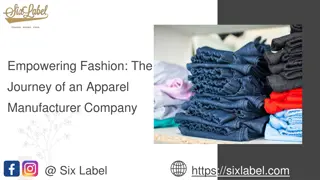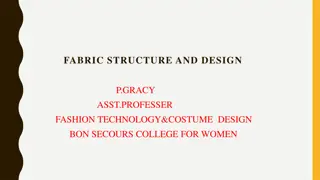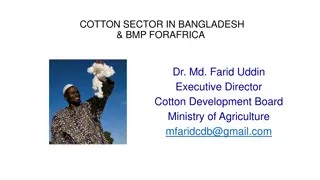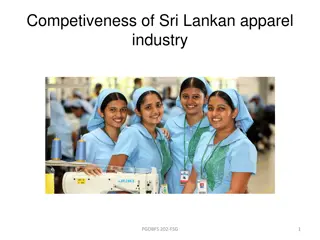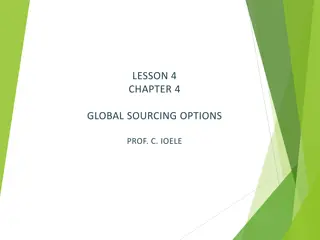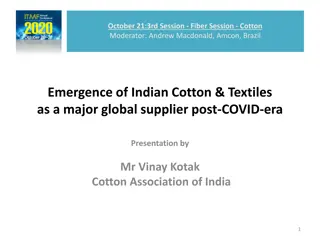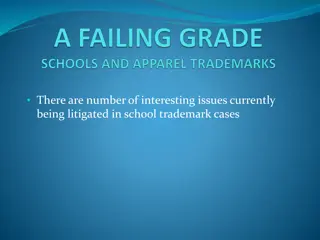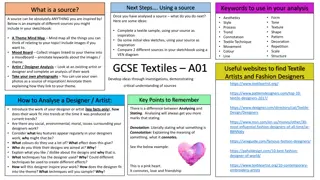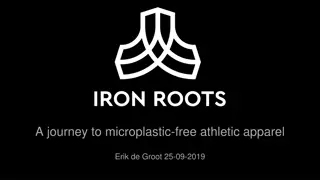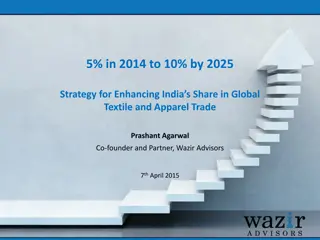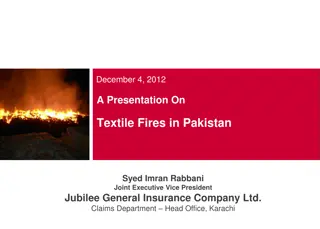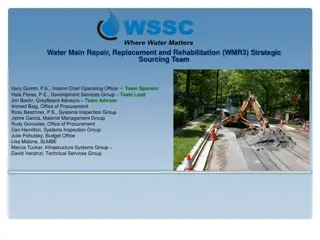Current Trends in Global Sourcing: Textile and Apparel Industry Insights
The evolution of global sourcing in the textile and apparel industry, from traditional suppliers to emerging market leaders like China, Bangladesh, and Vietnam. Discover the impact on key importers and exporters, analyze market dynamics, and delve into the significance of the new Silk Road initiative.
Download Presentation

Please find below an Image/Link to download the presentation.
The content on the website is provided AS IS for your information and personal use only. It may not be sold, licensed, or shared on other websites without obtaining consent from the author.If you encounter any issues during the download, it is possible that the publisher has removed the file from their server.
You are allowed to download the files provided on this website for personal or commercial use, subject to the condition that they are used lawfully. All files are the property of their respective owners.
The content on the website is provided AS IS for your information and personal use only. It may not be sold, licensed, or shared on other websites without obtaining consent from the author.
E N D
Presentation Transcript
LESSON 3 CHAPTER 3 TRENDS IN GLOBAL SOURCING PROF. C. IOELE
Learning objectives Current trends in global sourcing Leading textile and apparel importers and exporters Differences between old and new market environments Textile complex and soft goods industry North American Industry Classification System to analyze business activities within the industry Impact of global sourcing on manufacturing, wholesale, and retail 2 Global Sourcing in the Textile and Apparel Industry
Recall the definition of SOURCING and GLOBAL SOURCING from Lesson1 Sourcing: a set of business processes and activities by which businesses acquire and deliver components or fully finished products or services from outside of the organization, with the objective of: Finding, evaluating, and engaging suppliers for appropriate goods and services to achieve long-term competitive advantages. Sourcing is a B2B activity Global sourcing: same as sourcing, in a global marketplace Global Sourcing in the Textile and Apparel Industry 3
Watch..the old Silk road https://www.youtube.com/watch?v=vn3e37VWc0k The Silk Road and Ancient Trade: the first World Wide Web Of history Global Sourcing in the Textile and Apparel Industry 4
Watch..the new Silk road https://www.youtube.com/watch?v=EvXROXiIpvQ China's trillion-dollar plan to dominate global trade Global Sourcing in the Textile and Apparel Industry 5
New market environment Annually, the world exports over U.S. $800 billion worth of textiles and apparel (WTO). In the beginning developed countries used to be the suppliers of textiles and apparel in 1960s. Today China, Bangladesh, and Vietnam are the leading apparel suppliers/exporters. Turkey is steadily growing. United States and Japan are the major importers (or sourcers) of textiles and apparel. Global Sourcing in the Textile and Apparel Industry 6
Watch.. https://www.youtube.com/watch?v=aKWURy4vXjM TOP 10 TEXTILE MANUFACTURING COUNTRIES (1963-2019) - Top Textile manufacturing countries 2019 Global Sourcing in the Textile and Apparel Industry 7
Watch.. https://www.youtube.com/watch?v=1xkeaGpIyS0 World's Top 10 Exporting Countries [1960-2019] Global Sourcing in the Textile and Apparel Industry 8
New market environment Industry has been transformed from the old to the new market environments. Figure 3.5 Global Sourcing in the Textile and Apparel Industry 9
Nature of global sourcing Textile complex vs. soft goods industry The traditional view of the textile and apparel industry focused on manufacturing activities: the Fiber-Textile-Apparel (FTA) complex describes the overall picture of the textile and apparel manufacturing industry (fiber, yarn, fabric and apparel productions) as core business. As manufacturing activities moved from developed countries to developing countries, FTA complex has been associated with dying industry, plant closing, and domestic job loss. Instead, the relocation of manufacturing activities created new business activities and job functions. Global Sourcing in the Textile and Apparel Industry 10
Nature of global sourcing Business types Textile complex vs. soft goods industry Retailers are now directly involved in manufacturing through global sourcing. Manufacturers are now retailing their own products through online store formats. A new term, the soft goods industry, was developed, instead of textile and apparel industry. Global Sourcing in the Textile and Apparel Industry 11
Watch.. https://www.youtube.com/watch?v=GpzRI-mcvg8 Sustainable clothing Global Sourcing in the Textile and Apparel Industry 12
Answer.. Do you know what we mean by TEXTILES? Global Sourcing in the Textile and Apparel Industry 13
Textiles All the products that the FTA (Fiber- Textile-Apparel) complex produces fibers, yarns, fabrics, apparel, and so on. Global Sourcing in the Textile and Apparel Industry 14
Answer.. Do you know what we mean by SOFTGOODS? Global Sourcing in the Textile and Apparel Industry 15
Softgoods Nondurable goods that are usually made with textiles. Global Sourcing in the Textile and Apparel Industry 16
Answer.. Do you know what we mean by SOFTGOODS CHAIN? Global Sourcing in the Textile and Apparel Industry 17
Softgoods chain The total textile and apparel production-distribution chain, including retailing. Global Sourcing in the Textile and Apparel Industry 18
Answer.. Do you know what we mean by SOFTGOODS INDUSTRY? Global Sourcing in the Textile and Apparel Industry 19
Softgoods industry New business activities, such as importing, exporting, and other distribution-related business practices. Global Sourcing in the Textile and Apparel Industry 20
Watch.. https://www.youtube.com/watch?v=qvEnjKgBSCQ Apparel, Clothing and Textiles Industry: Globalization, Outsourcing, Retailing and E-commerce Trends Global Sourcing in the Textile and Apparel Industry 21
North American Industry Classification System (NAICS) Three North American countries (US, Canada, and Mexico) classify business activities following NAICS (1997), for the purpose of collecting, analyzing and publishing statistical data related to a nation s business economy. There are different levels of details of business types. More digits, more classifications/details. NAICS uses a 2 6-digit hierarchical classification system. First two digits = the economic sector Third digit = the subsector Fourth digit = the industry group Fifth digit = the NAICS industry (state comparability) Sixth digit = the national industry (country-specifics) Global Sourcing in the Textile and Apparel Industry 22
North American Industry Classification System (NAICS) Major economic subsectors There are 20 major economic sectors within NAICS. The first two digits explain the economic sector to which a business belongs. Most businesses in the textile and apparel industry belong to (a) manufacturing [31 33 economic sector] (b) wholesale trade [42 economic sector] (c) retail trade [44 45 economic sector] Global Sourcing in the Textile and Apparel Industry 23
Table 3.1. NAICS Economic Sectors Economic sector 11 21 22 23 31 33* 42* 44 45* 48 49 51 52 53 54 55 56 61 62 71 72 81 92 Global Sourcing in the Textile and Apparel Industry Description Agriculture, Forestry, Fishing, and Hunting Mining, Quarrying, and Oil and Gas Extraction Utilities Construction Manufacturing* Wholesale Trade* Retail Trade* Transportation and Warehousing Information Finance and Insurance Real Estate and Rental and Leasing Professional, Scientific, and Technical Services Management of Companies and Enterprises Administrative and Support and Waste Management and Remediation Services Educational Services Health Care and Social Assistance Arts, Entertainment, and Recreation Accommodation and Food Services Other services (except Public Administration) Public Administration 24
North American Industry Classification System Major economic subsectors Manufacturers [NAICS 31, 32, and 33]: Businesses engaged in the mechanical, physical, or chemical transformation of materials, substances, or components into new products. The assembling of component parts of manufactured products is considered manufacturing. Retailers[NAICS 44 and 45]: Businesses engaged in retailing merchandise, generally without transformation, and rendering services incidental to the sale of merchandise. The retailing process is the final step in the distribution of merchandise; therefore, organized to sell merchandise in small quantities to the general public. Global Sourcing in the Textile and Apparel Industry 25
North American Industry Classification System Major economic subsectors Wholesalers[NAICS 42]: Businesses engaged in wholesaling merchandise, generally without transformation, and rendering services incidental to the sale of merchandise. Wholesalers are categorized into three types of operations: merchant wholesalers (they own the goods for sale: distributors, jobbers) business-to-business [B2B] electronic markets (goods owned by others, they work on commissions) Wholesale trade agents and brokers (sales representative) Global Sourcing in the Textile and Apparel Industry 26
Watch.. https://www.youtube.com/watch?v=JzLoo8cFJBI Retailers, Wholesalers and Distributors Global Sourcing in the Textile and Apparel Industry 27
North American Industry Classification System Textile and apparel manufacturing subsectors: Subsector Description 313 Textile Mills 314 Textile Product Mills 315 Apparel Manufacturing 316 Leather and Allied Product Manufacturing Global Sourcing in the Textile and Apparel Industry 28
North American Industry Classification System Textile and apparel retail subsectors: Subsector Description 442 Furniture and Home Furnishing Stores 448 Clothing and Clothing Accessories Stores 452 General Merchandise Stores 454 Non store Retailers Global Sourcing in the Textile and Apparel Industry 29
North American Industry Classification System Textile and apparel wholesale subsectors: Subsector Description 42 424 4243 42431 424310 42432 424320 42433 424330 42434 424340 Wholesale Trade Merchant Wholesalers, Nondurable Goods Apparel Piece Goods, and Notions Merchant Wholesalers Piece Goods, Notions, and Other Dry Goods Merchant Wholesalers Piece Goods, Notions, and Other Dry Goods Merchant Wholesalers Men s and Boys Clothing and Furnishings Merchant Wholesalers Men s and Boys Clothing and Furnishings Merchant Wholesalers Women s, Children s, and Infants Clothing and Accessories Merchant Wholesalers Women s, Children s, and Infants Clothing and Accessories Merchant Wholesalers Footwear Merchant Wholesalers Footwear Merchant Wholesalers Global Sourcing in the Textile and Apparel Industry 30
Global sourcing by different business types Manufacturers and global sourcing From domestic manufacturing to low-wage countries. The United States is now importing over 95% of its textile and apparel products from foreign countries, including parts and components. Retailers and global sourcing Retailers are now directly involved in or indirectly affecting global sourcing. Focus on design, values, services and marketing. Buyer-driven supply chains rather than producer-driven . Direct business with foreign factories, direct involvement in manufacturing activities. Global Sourcing in the Textile and Apparel Industry 31
Global sourcing by different business types Wholesalers and global sourcing Wholesalers do not sell products to consumers and do not engage in product transformation, but they are involved in global sourcing. In the new market environment wholesalers offer value-added services (they buy an resell at a profit). The term wholesaling underestimates the importance of design, branding, marketing and logistics Identity crisis Global Sourcing in the Textile and Apparel Industry 32
Global sourcing by different business types Import intermediaries and global sourcing Domestic service firms that link domestic wholesalers or retailers with foreign distributors or manufacturers to facilitate import transactions in the global apparel supply chain. One of the main drivers of global sourcing in the new market environment. They may provide design, product-development, quality control, logistics. They are not included in the business classifications so far. Global Sourcing in the Textile and Apparel Industry 33
Today in the US Textile and apparel industry offers limited employment opportunities in manufacturing sectors, but hires sourcing managers,brand managers, chain managers, marketers, product developers, merchandisers, global supply chain managers, retail managers Global Sourcing in the Textile and Apparel Industry 34
Watch.. https://www.youtube.com/watch?v=ErwIlvQ_RVk America vs China: why the trade war won't end soon | The Economist Global Sourcing in the Textile and Apparel Industry 35
For the next class Read Ch. 4 (see pages on syllabus) Homework on textile and apparel (see instructions in MySRISA) Global Sourcing in the Textile and Apparel Industry 36
Learning objectives Current trends in global sourcing Leading textile and apparel importers and exporters Differences between old and new market environments Textile complex and soft goods industry North American Industry Classification System to analyze business activities within the industry Impact of global sourcing on manufacturing, wholesale, and retail 37 Global Sourcing in the Textile and Apparel Industry
